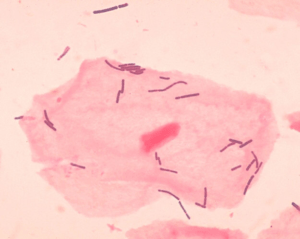
Lactobacillus organisms from vaginal smear
(Janice Carr, CDC/Dr. Mike Miller, Centers for Disease Control and Prevention’s Public Health Image Library (PHIL))
Tenofovir is used as a pre-exposure drug for HIV prevention in high risk individuals. While pre-exposure drugs have proven to be highly effective for men, studies on their efficacy on women have been inconsistent. In their study, Klatt el al. discovered a link between tenofovir efficacy and the type of vaginal microbiome in African women.
The vaginal microbiome consists of a wide variety of microbial species that maintain vaginal mucosal health. Vaginal microbiomes usually fall into two categories: 59.2% of microbiomes are Lactobacillus-dominant while 40.8% are non-Lactobacillus-dominant, where a high abundance of Gardnerella vaginalis and other anaerobic bacteria can be found. A dysbiosis of this microbiome is commonly referred to as bacterial vaginosis and occurs when a microbiome shifts from being Lactobacillus-dominant to non-Lactobacillus-dominant. While bacterial vaginosis is usually asymptomatic, it is associated with higher HIV infection risk.
In Klatt el al.’s study, 688 women were either assigned a tenofovir topical gel or a placebo gel to use. In the Lactobacillus-dominant group, consistent tenofovir use reduced the risk of HIV infection by 61% compared to participants who used a placebo. In the non-Lactobacillus-dominant group, consistent tenofovir use still reduced the risk of HIV infection, but only by 18%.
Upon closer inspection, the researchers noticed that the Lactobacillus-dominant group had much higher mucosal tenofovir levels compared to the non-Lactobacillus-dominant group. After testing the interactions between G. vaginalis and tenofovir, researches discovered that G. vaginalis metabolized tenofovir at a rapid rate. This explained the lower tenofovir levels in non-Lactobacillus-dominant participants, which led to a higher risk of HIV infection.
Journal Article: Klatt NR et al., 2017. Vaginal bacteria modify HIV tenofovir microbicide efficacy in African women. Science
Article by Maxwell Chan











